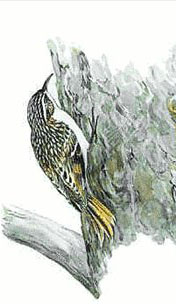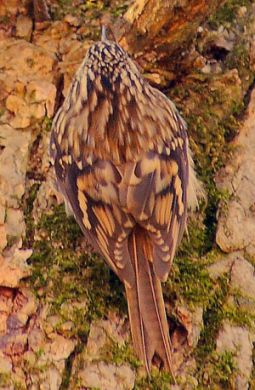Common Birds
Brown Creeper
A common winter bird that often goes un-noticed is the Brown Creeper. That is due to the fact that this bird, which forages for food on tree trunks, blends in so well it appears to be part of the tree bark until you realize it is moving. 
Brown Creepers are clinging birds of the tree trunk zone. They have brown upper parts that are spotted and lightly streaked resembling a piece of tree bark. Their under parts are white but due to the fact they are a mere 4.5 inches in length and cling so tightly to the tree it can be difficult to see. They have a small white eyebrow and the long bill is curved slightly downward. The long tail of the Brown Creeper is held stiff for support as they climb and probe the tree bark. Male and female Brown Creepers are monomorphic meaning the sexes are similar, although the male has a slightly longer bill.
Brown Creepers forage on tree trunks and branches spiraling upwards from the bottom of a tree trunk, and then flying down to the bottom of another tree. They creep slowly up the trunk with their body flattened against the bark, probing with their beak for insects and larvae, feeding on small arthropods found in the bark. During the winter months they may feed on seeds but are rarely seen feeding on the ground. Creepers will also feed on suets especially if the suet feeder is close to the tree trunk. A favorite trick of mine is to smear suet directly on the trunk of a tree.
Brown Creepers are a short distance migrant. They breed from Alaska to Newfoundland and southward down the western mountain ranges and in the forests of the Great Lakes region to the Northeast. Although some spend the winter in their breeding territories, many northern Brown Creepers move south every winter into the Great Plains and Midwest drifting as far south as the Gulf Coast and into Florida. The preferred habitats of the Brown Creeper is deciduous and mixed woodlands. During the winter months they are often seen in cities and backyards where large mature trees are available.
The breeding season for Brown Creepers usually starts in April. They are a monogomous solitary nester. The female will construct a nest in the shape of a partial cup made with small twigs, bark, pine needles and mosses in the cavity of a tree or under a partially dislodged piece of tree bark. Once the structure is completed she will line the nest with shredded bark and feathers and lay 3 – 7 white eggs with brown flecks. Incubation is carried out by the female for about two weeks while the male brings her food to the nest. Once the eggs are hatched both parents will assume the duties of feeding the young.
Although Brown Creepers may be difficult to spot they are easy to identify since there are no similar species in North America. If you happen to see them on a tree in your backyard you will certainly enjoy watching them. 
Fun Brown Creeper Facts:
• When Brown Creepers are threatened they will spread their wings and freeze against the tree trunk for several minutes. Their plumage blends in with the bark of the tree so well they are almost invisible.
• Brown Creepers start foraging for insects at the base of a tree trunk spiraling upwards and will ascend the trunk before hopping down to the base of the next tree where they will start again.
• A Brown Creepers nest will often have two openings. One opening will serve as the entrance and the other the exit.
• A group of Brown Creepers are known as a “sleeze” or a “spiral” of creepers.
